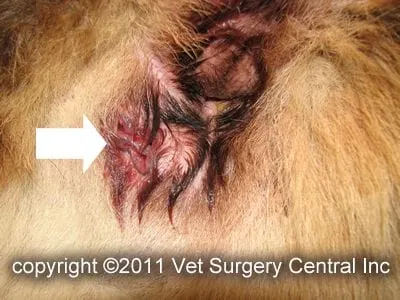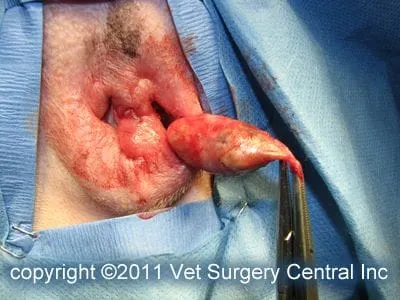Key Points
Anal sac conditions may require surgical removal of them
Complications are rare in the hands of experienced surgeons
Permanent relief of chronic anal gland conditions such as impaction, infection, and abscessation can be achieved with surgery
Anatomy
The term “anal gland” and “anal sac” are used interchangeably. Anal glands are a pair of scent glands located along the side of the anus. The anal gland has a small duct (tube) that opens on the rim of the anus. As formed stool passes through the anus, a small amount of the anal gland secretion is released. The foul smelling secretion is used to mark the pet’s territory. The external anal sphincter wraps around the outer side of the anal gland. This muscle acts as a valve to prevent stool from dropping out of the rectum and can be consciously controlled by the pet. The internal anal sphincter lies on the inner side of the anal gland and its control is dependant on the autonomic nervous system, which means it, is not controlled by direct conscious thought processes. Cells that produce a thick, brown colored, fishy odiferous material line each anal gland. Interestingly, each dog’s anal gland secretion is unique and identifies the individual pet, like a fingerprint. Thus, a dog’s territory is marked by the scent of the secretion. Skunks spray the contents of their anal glands as a form of defense against predators; without these glands they are helpless. Dogs and cats, however, can function normally without these scent glands.
Anal Gland Conditions
Anal glands can become impacted; this means that the secretion is too thick to be excreted naturally. The secretion becomes thicker as it stagnates in the anal gland. If the duct of the anal gland becomes narrowed due to inflammation, scar tissue, or for other reasons, the secretion cannot escape from the gland. Infection of the anal sac may accompany anal sac impaction. With infection, pus forms in the anal sac. A swollen or scarred duct may not allow the infection to escape from the gland, thus the gland ruptures internally and the infection spreads to neighboring tissues. As the abscess (pocket of pus) enlarges, it will break through the skin at the 5 and 7 o’clock positions around the anus (see photo below – arrow).
Signs
Warning signs of an impacted anal sac may include dragging or “scooting” the dog’s anal area on the ground or floor. Anal gland infection likewise may present with signs of scooting and licking of the anal region. Anal sac abscessation is much more painful and the pet may try to bite the owner if the hind end is touched. In addition, the pet may have a red or purple raised area (lump) along side of the anal region, may strain excessively during bowel movements, or may refrain from having bowel movements, be constipated, and may carry the tail very low. If the abscess has ruptured, a bloody material may ooze from a hole in the skin near the anus and the pet will feel much better. Commonly, once a dog develops an abscess of the anal gland, then the problem will recur repeated.
Medical Treatment
Impaction of the anal glands is treated by manually emptying of the anal glands on a regular basis. Typically, this is done monthly by a veterinarian. Anal gland infection may not respond to oral antibiotics, as the glands normally have a blood-anal gland barrier. Thus the treatment usually entails expressing all secretion from the gland and filling the gland with an antibiotic/steroid medication via the duct of the anal gland. Many veterinarians use a product called Panalog, but other products can also be used. The anal gland always should be evaluated about 2 weeks after treatment to ensure that the infection is resolving and the treatment is usually repeated. Abscessation of the anal glands should be treated with surgical drainage of the abscess, flushing the area, infusion with Panalog and administration of oral antibiotics. At home, application of a warm compress to the affected area, cleaning discharge from the anal and perianal region with baby wipes and administration of medication (pain meds and antibiotics) may be needed. If the pet is constipated, a stool softener may be prescribed. When more than one episode of abscessation of the anal gland occurs, surgical excision of the anal gland is recommended. Ideally, the infection should be treated first with antibiotics for a few weeks prior to surgical removal of the gland.
The day of surgery
The anesthesia and surgical team will prescribe a pain management program, both during and after surgery that will keep your companion comfortable. This may include a combination of general anesthesia, injectable analgesics, epidural analgesia, oral analgesics, and anti-inflammatory medication.
Surgery
Anal gland removal (anal sacculectomy) is procedure that will provide the pet with permanent relief of anal gland impaction, infection, and abscessation. The procedure entails making an incision near the anus over the anal gland. The gland is gently dissected from external and internal anal sphincters. Care is taken to minimize disruption of the anal sphincter, as this could result in permanent fecal incontinence. Some surgeons prefer to remove only the affected anal gland and leave the normal gland intact, as unilateral anal sacculectomy is not associated with fecal incontinence. The owner may find stool nuggets around the home or in the pet’s (or owner’s) bed if a pet develops fecal incontinence. If fecal incontinence is very mild, the owner may note that the dog passes more gas, yet the pet has full control of the stool. If a piece of the anal sac is left in the patient, an abscess or chronic draining tract may develop. If the surgeon inadvertently cuts a hole in the side of the rectum during removal of the gland, a nonhealing fistula (channel) may develop from the skin along side of the anus to the rectum. In the hands of an experienced surgeon, these complications are uncommon.
Aftercare
While your pet is recovering at home, a pain relieving medication should be administered, as directed by the pet’s surgeon. Antibiotics are commonly prescribed. If your pet does not pass stool after 3 to 4 days after surgery, a stool softener should be administered. Unflavored metamucil, lactulose, or other stool softener can be administered to the pet until bowel movements are seen. If the pet is very irritated following surgery, a medication called Proctafoam will be prescribed. This medication, which contains a corticosteroid and local anesthetic medication, is instilled into the rectum with a special applicator for about 5 days. The incision should be checked daily for signs of infection, which include swelling, redness, pain, and discharge. The pet, when not under direct supervision, should wear an Elizabethan collar. Pet stores and some veterinarians sell inflatable Elizabethan collars which are much more comfortable and better tolerated than the traditional “lamp shade” style Elizabethan collar. External sutures, if present, are removed from the anal region in about 10 days after surgery.





